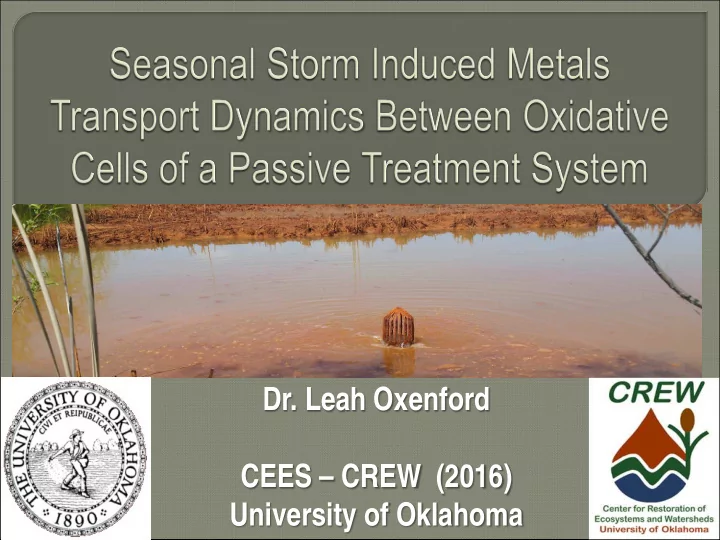

Dr. Leah Oxenford CEES – CREW (2016) University of Oklahoma
PHYSICAL CHEMICAL Neutralize acidity Design treatment cells to direct and indirect optimize hydrology: Metals removal and retention • Storage / Surface Area oxidation / reduction ppt / sedimentation • Hydraulic Retention Time Alkalinity generation • Elevation Change / Aeration
ACUTE (SHORT TERM) CHRONIC (LONG TERM) Direct precipitation Changes in loading Surface runoff (system) Erosion of berms Storm Drainage Field work schedules Construction Schedule Remote monitoring
ACUTE: To determine the relationship for rainfall intensity and total iron transport between the oxidative cells of a passive treatment system. CHRONIC: Determine the significance of storm induced mass transport seasonally and annually with respect to baseline transport.
SAMPLING / MONITORING DATA INTERPRETATION 10 years of storm data 40 storms sampled over a evaluated for sampling three year period. threshold values. Intensity classification: Precipitation (yield) • Low (0.25-0.99 cm/hr) Duration (hours) • Moderate (1.00-1.99 cm/hr) Frequency (#) • High (2.00-2.99 cm/hr) Intensity (yield / hour) • Extreme (>3.00 cm/hr)
Storm Classification
Autosamplers collect 24 samples with local rainfall intensity trigger and monitoring. Samples processed and analyzed for total metals.
C1Out: Average Moderate Iron Transport Profile (0.253; 1.47 cm/hr) 39.98 1.98 Iron Rainfall Intensity 34.98 Rainfall Intensity (cm/hr) 29.98 1.48 [Fe] Tranport (ppm) 24.98 19.98 0.98 14.98 9.98 0.48 4.98 -0.02 -0.02 -0.5 4.5 9.5 14.5 19.5 24.5 29.5 34.5 Time (hours)
The amount of iron transported does not correlate to rainfall intensity, duration, or storm yield. Rainfall events induced significant iron transport over baseline during the 30+ hour monitoring period.
Storm Induced % of Transport Loading Fe Total Transported Fe Transport Storm Induced (kg/year) Fe (kg/year) (kg/year) (%Net Transport) C1Out 34767 7862 1067 13.6% C2N 7862 1220 165 13.5% C2S 7862 1019 113 11.1% 301 152 49 34.8% C6Out
RESUSPENSION SETTLING DISRUPTION Not likely due to depth of Iron transport peaks ~15 treatment cell (>1.5m) hours after a rainfall event. No observable trend Floc fragmentation and between transport and mixing of surface zone. intensity. Settling disruption Resuspension is not supported by Stokes Law supported. calculations.
Storms transport Fe between cells in the oxidation unit independent of rain fall intensity, duration, and yield. Storms do not induce export of Fe from the treatment system due to oxidative cell placement early in the treatment series.
There is no significant difference between seasons for storm induced iron transport. There is no significant difference between years and storm induced iron transport. Transport mechanism is disrupted sedimentation rather than resuspension
Impact of the temporal distribution of storms on mass transport. • # of storms per transport event • # and frequency of storms preceding event Transport profiles for trace metals • (Cd, Pb, Zn, and more) • Correlation to iron via surface sorption
OU Committee Nairn Crew Funding
Recommend
More recommend